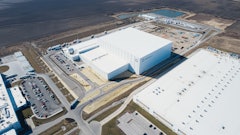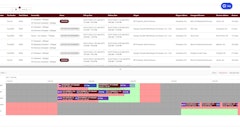Businesses in the cold chain today are faced with a transportation capacity shortage while new and existing customers are requiring smaller, more frequent, shipments to meet their lean inventory objectives, according to the findings of a recent survey conducted of Food Logistics readers.
Food Logistics and AmeriCold Logistics, Atlanta, conducted the survey to determine how companies are adapting to changing cold chain business requirements. It came as no surprise to find that the capacity shortage the trucking industry is currently experiencing--coupled with the smaller shipment size requirement--has placed companies in a challenging situation.
More than 50 percent of the respondents' customers are requiring smaller shipment sizes and more frequent shipments that drive up the cost and complexity of moving product.
The study revealed that most companies are utilizing multiple modes of transportation instead of relying on one mode to meet total transportation needs; however, trucks are the primary mode of transportation. Full truck and multi--stop trucks (63 percent) are the transportation modes most utilized, followed by private fleets (23 percent).
Respondents are somewhat likely and very likely to increase the use of truckload (TL) and less--than--truckloas (LTL) services within the next year, adding additional capacity pressure on these modes.
As a result of the capacity shortage, 41 percent of the respondents have an active plan in motion to relieve carrier capacity issues and control costs. An additional 23 percent have a plan on paper ready to be implemented.
Businesses have a variety of options when it comes to addressing their transportation challenges. Improvement initiatives are categorized as operational programs, technology--enabled programs or capital--intensive programs. Here's how these options address today’s challenges:
Operational Programs
Operational programs focus on both the physical movement and storage of product, and the information flow from purchase order receipt to customer delivery. Generally offered by third--party logistics providers (3PLs), they are aimed at increasing the level of service while controlling cost. Some of the programs were designed to help the shipper, while others were designed for the consignee. Regardless for whom the program is designed, either party can reap some kind of cost or service benefit through participation.
Third--party logistics providers can manage the information flow associated with operational programs through the use of multi--platform messaging and Web reporting tools. The use of barcode scanning, messaging and the Internet allow for real--time status of inventory, orders and transportation and provide customers with supply chain visibility. With visibility, decision--making can be more effective, allowing for proactive instead of reactive decisions.
The operational programs include:
Consolidation warehousing: Consolidation warehousing is the most commonly planned or implemented operational program, with 39 percent of the respondents participating in this program today and another 32 percent either planning or thinking about using it in the future. Consolidation warehousing pools products from multiple manufacturers shipping to a common destination through intermediary facilities. Product typically arrives at the consolidation warehouse in a full truckload shipment from the manufacturer and then is ordered in smaller less--than--truckload (LTL) quantities by retailers, wholesalers or foodservice providers.
The service provider strategically consolidates these LTL orders from multiple manufacturers into shipments destined to the same geographic region or customer by using tactical transportation modeling tools. These tools use customer and purchase order date requirements as input and look to minimize cost by selecting the most appropriate mode and carrier, optimizing routes and generating a detailed load plan. Participants benefit from shared transportation costs as the load size increases from shared routes and delivery locations.
Cross--docking: Almost as prevalent as consolidation warehousing, 37 percent of the survey respondents currently cross--dock product through intermediary facilities before shipping on to their final destination and another 33 percent either plan or are thinking about using this type of transportation program in the future.
Like consolidation programs, designated locations, called pool points, are used to receive goods and to fulfill LTL demand ultimately destined for a market located in close proximity to the pool point. The initial truckload shipment is received in and moved directly to shipping against an open outbound customer order without ever being stored at the facility. Inventory velocity is increased by eliminating both the put--away and storage processes. The key to accomplishing cross--docking is to link the receiving process to an open order. The order is then consolidated and routed on to shipments with other orders.
There are many types of cross--docking initiatives based on activities performed on the shipment and time associated with it. The cross--dock program types are listed in order from simple to complex and provide detail of what happens to shipments once at the designated pooling facility.
Multi--vendor consolidation: Twenty--five percent of survey respondents currently participate in multi--vendor consolidation programs. Despite its low current employment throughout the cold chain, this program has the highest level of interest among respondents, with 41 percent either planning or thinking about planning multi--vendor consolidation for their future. Multi--vendor consolidation programs aim to offset increased transportation costs by consolidating LTL shipments from multiple manufacturers ultimately destined for the same retail, wholesale or food service destination.
Multi--vendor consolidation programs work through the use of service providers like 3PLs who manage manufacturers’ truckload--sized shipments at their facilities. The inventory from multiple manufacturers is ordered in consolidated truckloads by retailers, wholesalers or foodservice providers. This type of program enables the consignee to receive product when he wants it, thereby enabling him to better manage inventory investment, lead--time and use of dock doors and warehouse space. Multi--vendor consolidation is an example of a demand--driven supply chain where the ultimate consumer drives the process.
Transportation management outsourcing: Fifty--eight percent of the survey respondents have expressed no interest in outsourcing their transportation functions to outside transportation management providers. It is worth noting, however, that these outside providers can offer a full menu of transportation management services and can provide a single point of contact for clients, allowing companies to focus on their core competencies.
From an operational perspective, transportation management providers can leverage the total volume of freight they control throughout the supply chain to negotiate better rates and improve carrier availability. On behalf of a supplier, transportation providers can receive orders, tender freight and send advanced shipping notices to the consignee through electronic messaging. By leveraging carrier relationships, volume and technology, the outsourced transportation management solution can minimize cost and help secure the necessary transportation assets to fulfill demand.
Technology--Enabled Programs
Track and trace/event management: Track and trace is typically performed manually by pulling status from each carrier’s Web site or by calling the carrier directly. There is, however, supply chain technology that provides both visibility and event management capability. Twenty--two percent of respondents indicated that they currently use track and trace and event management tools to reduce costs or capacity issues and another 32 percent are planning or thinking about using it in the future. The level of automation that respondents are currently or thinking about using to track and trace shipments and manage events is unclear from the survey.
Track and trace and event management applications are Web--based tools that provide total visibility of in--transit shipments and major milestones, such as proof of delivery across multiple modes and carriers. From an event management perspective, the tool sends different types of alerts based on the defined business rules and parameters. For example, an e--mail alert may be sent to notifiy the shipper if the product has not been received at a location within a certain delivery window. The shipper can then proactively trace the shipment and notify the consignee of the pending delivery delay and revised delivery schedule.
Internet marketplace: Eleven percent of the survey respondents currently use Internet marketplaces, while almost a full half of them have no interest in participation whatsoever. Internet marketplaces for transportation--related services are constantly changing, evolving and unfortunately, disappearing. After the "dot com" bubble burst a few years ago, the supply of freight bidding and matching services was far greater than the demand of companies willing to try this new business enabler. Those service providers that remain may be operating in a significantly different environment than they had initially planned as providers have diversified into more traditional transportation fields, such as freight bill audit and payment, track and trace, document imaging and the like. The savings are de--pendent on the shipment characteristics, including weight threshold limits, time and lane.
Capital Intensive Programs
Private/dedicated fleet: Thirty--one percent of the respondents currently use a private or dedicated fleet to transport their goods and another 26 percent are planning, or thinking about, investing in a private or dedicated fleet for the future. The decision to utilize a private or dedicated fleet is a tradeoff between cost and service. The cost of a private fleet includes maintenance facilities and staff, parts inventory, tools, equipment, software and more. With the current capacity shortage, however, private fleets allow greater control over capacity and the delivery event. A dedicated fleet does not require the capital investment of a private fleet, but the shipment is in the hands of a third party who does not have true ownership of the product and the delivery event. Additionally, private and dedicated fleets are able to minimize the effect of Hours of Service rules by smoothing service variability through the control of their own assets.
Relocating operations: More than 65 percent of the respondents expressed no interest in relocating operations. Relocating operations can mean a large capital investment, coupled with additional financial risk. Many companies are not willing to take this option as is reflected in the survey results.
Utilization of 3PLs that specialize in providing warehousing and distribution services in dry, ambient, refrigerated and frozen environments is a good way to minimize these risks and offset the capital requirements for relocating or opening a new facility. 3PLs offer a wide range of warehousing and distribution operations that are tailored to specific client requirements, whether it be a large--scale or smaller hub facility, client--dedicated or multi--user facilities, or a supplier--owned inventory environment.
The first step in any facility relocation would be to perform a network design analysis. This allows companies the ability to evaluate their current supply chain against alternative network designs and assess the cost and service impact of changing the current infrastructure. The study can start as far upstream as to what vendor should supply which raw material. The further upstream the study goes the more accurate and cost--effective the newly designed network can be. The technology used in strategic modeling can be expensive and models can be difficult to build. Companies, therefore, may want to outsource rather than making an in--house investment in the software and training existing staff or hiring from the outside.
Collaboration
Although not categorized as an improvement program, respondents overwhelmingly believed that collaboration with suppliers, customers and carriers will help mitigate transportation issues. Furthermore, 60 percent believe that collaboration and communication will improve somewhat in the future. Collaboration with trading partners is fundamental to doing business within the cold chain and can occur at the most basic level through communication, relationships and sharing plans and information.
From a supply chain technology perspective, multi--platform messaging with other supply chain partners and systems provides companies with real--time visibility of supply and demand. This enhances collaboration between cross--functional processes and allows inventory to be tracked and events to be managed. This can lead to more informed and rapid decision--making, improve transportation reliability and provide the ability to proactively address the impact of exceptions or unexpected events throughout the entire supply chain.
In Summary
Cost and capacity availability will only get worse before it gets better. Fifty--six percent of the respondents believe that costs will continue to rise over the next year and 41 percent believe that capacity will still be a challenge. With this said, only 20 percent of the respondents were pessimistic about the direction in which their transportation component of the cold chain is heading.
Forty--three percent are at least somewhat optimistic that the transportation component of the cold chain is heading in the right direction. This positive outlook may be attributed to the fact that companies are planning for the future and rolling out programs and technologies that will address transportation challenges. Additionally, companies are strengthening their relationships and increasing collaboration with supply chain partners.
ABOUT THIS SURVEY:
To determine cold chain trends in the food and consumer goods industry, Food Logistics and AmeriCold Logistics, an Atlanta--based third--party provider of temperature--controlled storage and distribution services, conducted an e--mail survey of subscribers to Food Logistics. The survey was conducted between December 2004 and January 2005.
Tracy Sobeck, a supply chain consultant wirh AmeriCold, and Darren Frost, a manager in AmeriCold's supply chain service, conducted the survey and compiled the results. One hundred and twenty--five companies representing a good cross--section of upstream and downstream participants in the cold chain submitted responses to the survey questionaires.
The survey was conducted to determine how companies in the cold chain are adapting to changing business requirements and what programs and technologies have been implemented to address these transportation challenges. It also provides insight as to what supply chain initiatives are being planned or thought about for the future and what their anticipated impact on key performance indicators will be.
Overall, 31 percent of respondents manufacturer product, 27 percent provide warehousing, distribution or transportation services, and 42 percent demand product.
The majority of respondents represent smaller companies with annual revenues of less than $100 million (62 percent) and an annual transportation spend of less than $10 million (64 percent). These companies are not spending significantly more or less on transportation as a percentage of revenue than other companies within the same revenue bracket.
Most survey respondents handle product requiring temperature control, with the greatest percentage handling a random mix, followed by refrigerated and frozen. Almost 80 percent handle and transport packaged/processed foods;
72 percent handle meat;
67 percent handle baked goods; 65 percent handle dairy; 52 percent handle seafood;
51 percent handle non--food items;
47 percent handle produce;
45 percent handle liquids;
45 percent handle seasonings; 40 percent handle raw materials;
and 18 percent handle items identified as "other."


























